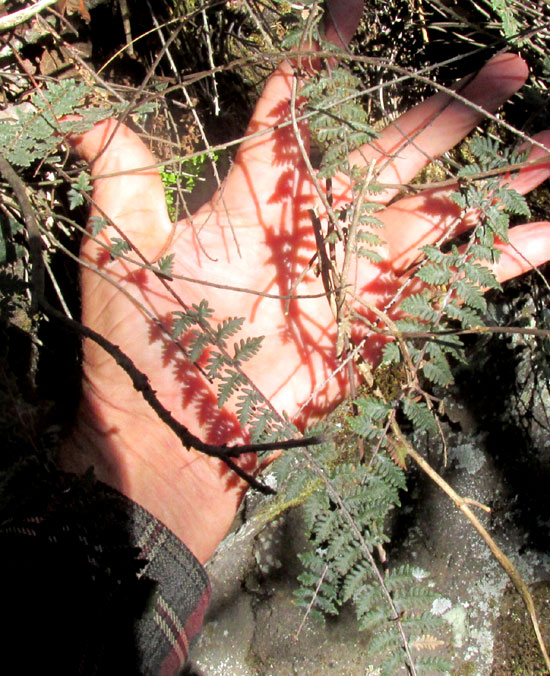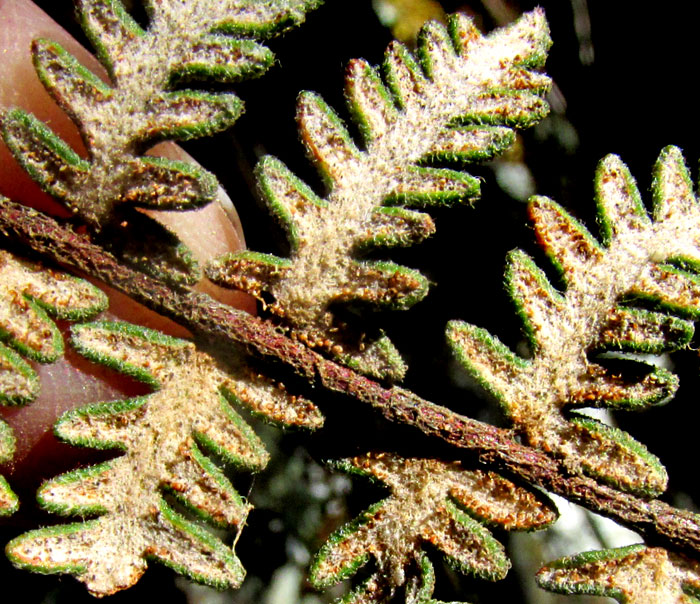Excerpts from Jim Conrad's
Naturalist Newsletter
entry from field notes dated July 1, 2022, on Cerro de la Cruz, at elevation ~2885m (~9465 ft), just south of the community of El Pinar, Amealco de Bonfil, Querétaro, MÉXICO, (~N20.17°, ~W100.17°)
BONAIRE LIP FERN

On the lower, eastern slope of Cerro de la Cruz, at the top of a roadcut into dirt made so long ago that lichens, mosses and ferns encrusted its vertical surface, the above fern's fronds were long and narrow, at the ends of exceptionally long stems, or stipes. The frond's surface was very hairy:

The hairs on both the pinnae's surfaces and the frond's central stem, or rachis, were stiff, bent close to the surface they arose from, and they were all similar in length and form. No scales were mixed among the hairs. Attention to these details was given because the fern's size, the form of the pinnae and the hairiness suggested the species' membership in the big group of ferns known as lip ferns. When the frond's undersurface was examined, it was clear that that's what they were:

The many brown, grain-like sporangia -- each containing 32 spores -- arose at each pinna's margin, which was turned under to form the lip.
In the old days the lip ferns all were lumped into the big genus Cheilanthes, home to about 150 species, mostly in the Americas. Nowadays that genus has been broken into smaller ones, but all the species still are called lip ferns. And with so many species -- about 27 just in our dry, upland region of central Mexico known as the Bajío -- distinguishing them can be hard.
However, this particular species was distinctive enough to be identified relatively easily. Its fronds being once-pinnately divided (instead of twice, thrice or four times, as with most lip fern species), with the pinnae being deeply lobed but not completely subdivided, and lacking scales mixed in with the hairs -- that was enough to peg it.
It's the Bonaire Lip Fern, HEMIONITIS BONARIENSIS, occurring on rocky slopes and ledges on many soils, in many habitats, at elevations from 950-3050 meters (3000-10,000 ft), from southeast Arizona, southern New Mexico and western Texas, as well as the Caribbean area, south to northern Argentina and Peru. This is an adaptable species commonly encountered at many New World locations.
Despite our fern being so well provided with sporangia, chromosomal studies suggest that the Bonaire Lip Fern is "an apogamous triploid that arose through autopolyploidy," as the Flora of North America so succinctly says of the species. That means that instead of having the normal two sets of chromosomes, Bonaire Lip Ferns possess three, making them "triploids." And when this genetic accident happened, no second species was involved, so the species is an "autopolyploid." Moreover, being "apogamous," our fern reproduces asexually, so the various Bonaire Lip Ferns growing along our embankment were all clones.
But, being an apogamous triploid fern seems to be a successful strategy for survival, because the Bonaire Lip Fern is one of Mexico's mostly commonly encountered fern species.